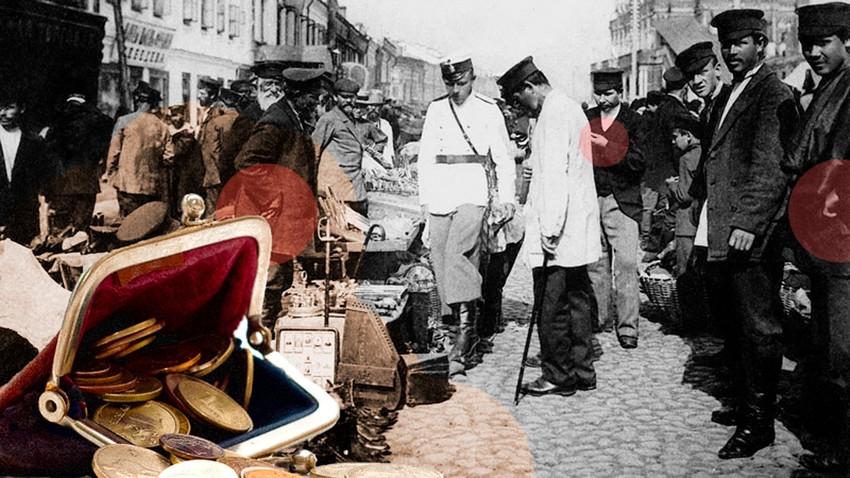How did Russian pickpockets work?
Already in pre-revolutionary Russia, in the patios of seedy urban neighborhoods, the following idyllic scene could be witnessed: An old man with a gray beard plays a particular game with street children. He hung a coat from a tree branch and attached numerous bells of different sizes to it. Then he would button up his coat and put a bill in the inside pocket. The child who managed to extract it without ringing a single bell was the lucky winner.
“Why would I choose murder? I am a born pickpocket”
A pickpocket arrested at a tram stop, still from 'The meeting place cannot be changed', 1979.
Stanislav Govorukhin, 1979, USSR Gosteleradio, Odessa Film StudioPickpocketing is a criminal enterprise few can master. The ability often manifests before the child reaches puberty, so old seasoned thieves used to replenish their ranks by making young children into future pickpockets, luring them with the aforementioned game or impressive magic tricks. Criminologist Leonid Belogritz-Kotliarevski recalls the following story: “Professors from the world of thieves showed right there, in a public square, how sleight of hand works: they took a snuffbox out of a passerby's pocket, sniffed the tobacco, and put it back in. without the man noticing, simply continuing on his way".
Crime investigator Alexander Kuchinski writes: “High-level pickpockets are born. One must naturally possess a particular nervous system, instantaneous and precise reactions, a particular constitution of the fingers, palms, elbows and shoulders, as well as a necessary aptitude for the artistic." And these are inclinations that required years of perfecting and were no less difficult than the training of magicians or gamblers. By the way, if you ever hear someone mention "finger bending" in relation to Russians, it's a nod to the arduous practice of training finger plasticity while locked up in jail, something thieves would do with everything. that time on your hands.
“Skill is impossible to teach,” according to Soviet-era pickpocket Zaur Zugumov. “However, the thieves exchanged experiences behind bars. While we were serving our sentences in the labor camps, in the workshop areas, we would make a mannequin and hang bells on it: this is how they honed their skills as thieves. With each ‘training session,’ I would try to get closer to the time when not a single bell would ring.”
Shift change at Khitrov market, Moscow
Public domainBut why the need to be such an artist? Well, the first pickpockets appeared in Russia at the time when the first paper money and exquisite body jewelry did, that is, in the 19th century. They worked mainly in the places with the greatest influx of public: theaters, banks, expensive shops. In order not to arouse immediate suspicion with their manners and appearance, pickpockets had to have a suitable appearance. “If any reader were to come across such a thief, they would find it hard to believe that they were dealing with a professional criminal,” wrote the noted early-20th-century lawyer and criminologist Grigori Breitman. “This type of thief is likely to resemble a doctor, lawyer, or insurance agent: he has a pleasant appearance and impeccable manners; he wears a luxurious suit, always made to measure by the best tailors. It is understandable that such a thief, especially if he has front row seats in the theater, would not arouse anyone's suspicions.
That's why the first pickpockets earned the right to be called the “knights” of the criminal world. They never resorted to violence, threats and weapons, while their victims were mainly rich people, which cleared their conscience and guaranteed a more or less tolerant attitude on the part of the tsar's police. And it is understandable that a thief who stole a purse from some wealthy merchant would be treated better in the interior than a murderer or an armed robber. “Why would I choose murder? I am a born thief, a born pickpocket. You can cross Russia on foot and ask anyone: Could a pickpocket murder another human being? Everyone would laugh in your face." These words (a quote from the pre-revolutionary journalist Vlas Doroshevich) belong to an Odessa pickpocket, illegally detained on suspicion of murder.
In the 19th century, “aristocrats” and policemen used to be known: cities weren't that big back then and there weren't too many thieves either. Also, pickpockets used to work in popular places and areas. “The same moral degradation is not likely to be observed among these thieves as with other criminals,” Breitman writes. "Almost all of them have a family, a place to live, children...and many grow up to be respectable people."

There were police records of all the famous thieves of the time; In addition, they were well known to all the "filyors" (trackers), policemen in civilian clothes, who worked in public transport and in places of mass gatherings. But then why weren't pickpockets actively prosecuted?
The sieves, the thieves, the fishermen...
Yaroslavsky railway station, Moscow. Pickpockets could quickly get lost in a crowd like this.
Anatoly Morozov/SputnikBeing educated men, versed in the word of the law, thieves understood that they could only be caught at the scene of the crime, when they snatched a wallet from their victim's pocket. If a fill-in officer or other cop missed the moment, they would never be able to prove that the (supposedly) stolen money hadn't simply fallen out of the pocket. Finding the wallet on his person was nearly impossible within seconds of the crime: either the perpetrator would quickly pocket the money and dispose of it, or pass it to an associate in the crowd, who casually walked away. The thief might even diligently help the victim find their money. And if he is suspected after all, the artistic skills of the pickpocket come into play, and he begins to feign his indignation profusely. Upon a search, no money would be found, of course. This is why the police in tsarist Russia often ended up arresting pickpockets as a preventive measure. The only thing they could really do was banish the man from the city, but it was of little use, since his concern allowed him to easily "run" the whole place.
Some were certainly caught red-handed. Breitman describes how a detective once apprehended the infamous pickpocket Aniutka-Vedma (“Aniuta the Witch”). On one occasion, one of the theaters in St. Petersburg became the scene of four robberies in one night. Detectives were in a state of utter confusion as they searched for a male pickpocket. At one point, one of them noticed an old woman who was in a suspicious hurry to make her way through the crowd.
“He saw the lady put her hand into the pocket of a gentleman who was nearby. The delighted detective instantly grabbed the thief's hand and held it in the man's pocket without letting go. The gentleman then attacked the detective, loudly proclaiming: 'Your hand is in my pocket!' 'My apologies, sir,' replied the detective. Please inspect my hands.' Looking closer, the gentleman saw that the detective's hand…was grasping that of a well-dressed lady, who was trying in vain to free her doll. 'Oh, ma'am!' was the only phrase the astonished gentleman could muster."
Municipal police officers in Saint Petersburg. April 2, 1917.
SputnikAfter the revolution of February 1917, the Provisional Government granted amnesty to the prisoners of the tsarist regime: numerous thieves of all kinds were released. In addition, the conditions had changed: now there was public transport; the railway network was expanded; the gathering places of the masses grew in number. The people, for their part, became impoverished. The change also did not spare pickpockets. Although they never lost their aristocratic status in the world of crime (they still refused to inflict bodily harm on their victims), what changed were their methods.
The Schipachi and the Verjushniki (“sweethearts” and “those with the top hats”) aroused a certain amount of contempt in the rest of the pickpocketing world: they picked from coat pockets. “They are going to work as a group,” Kuchinski writes. “And they prefer mass gatherings: demonstrations, public celebrations, crowded markets. While some schipachi are in charge of misleading the victim, others get to work in the pockets and bags. Then the teams switch places. If the operation is detected, pickpockets can drive the indignant victim back, distract them, and even put on a comic show with chants of “Catch the thief!”
The shirmachi (let's call them “concealers” or “screens”, for lack of a better word, since shirma in Russian is the screen used to change clothes) were the type that covered the bag or the pocket of the victim with a "case" - perhaps a folded coat or a bouquet of flowers - and used the same hand that was holding the case to extract the money, using the free hand to pass the ticket on public transport, wave a newspaper or gesture to distract the attention of the victim. Here, just like in the old days, one again had to rely on his artistic skills. Zugumov recalls how he stole a wad of bills from a worker who had just received his pay. The money was in the trouser pocket, under another layer of it: “As soon as the tram approached, I went in together with the victim. After making sure that the money was indeed there, I went to work. There was a moment when he spoke to me. Imagine my predicament: my left hand was inside my victim's trouser zipper, fingertips gripping the wad of 10-ruble notes by the corners, while I smiled pleasantly at the victim and continued the dialogue... ”
There were even the so-called ribolovi or “fishermen”, who used hooks and lines to extract the wallet from the bag. They often worked on long-distance trains, taking the top shelf and lowering the hook to the cabinmate's belongings below.
My hands are my bread
Policemen in a Moscow market, 1909-1910
Collections by A. Melitonyan/russiainphoto.ruThe highest caste of pickpockets were the pisari, the “engravers,” who cut (or raspisivali, “engraved”) the clothes or bags of people in the crowd. “Until about the 70s,” recalls Zugumov, “they sharpened a 20-kopeck coin and worked with the edge. It could easily be hidden inside the mouth. So much so that they often forgot it was there, and ate and slept with it on."
But why hide the coin in your mouth? Well, Soviet laws had evolved over time to be more effective in catching thieves: there was the new legal concept of "stealing by using technical means." The sharp coin is obviously a means, or a tool, and finding it could easily land the pickpocket in jail for up to 10 years. By the way, it was the “fishermen” who came up with a solution for that, fully opening their fishing rods in front of the police and claiming that it had nothing to do with the theft. This ingenious action could only be proven as ordinary theft, which carried a sentence of only five years.
The thief's main tools, however, were his psyche and his hands. That's why his only mortal enemies were bad habits and aging. “Lavish dinners and sleepless nights, spent in the company of women or playing cards, only dulled a person's reaction and alertness,” writes Kuchinski. “Smoking and eating too much affects the sensitivity of the fingers. And then, on top of all that, aging adds the ossification of movement."
Soviet militia in 1991.
Anatoly Morkovkin, Alexander Shogin/TASSA prison sentence or a sting in a labor camp were the thief's biggest fear, of course. There they will ruin everything: his psyche, his hands. The Soviet prison system displayed none of the nuances of generosity one might expect from the pre-revolutionary police. In the 1920s, which saw the heyday of pickpocketing, thieves could just break their fingers. Being sent to do forced labor at the Dnepro hydroelectric power station or on the Belamar canal, coupled with the horrible living conditions in prisons, destroyed any hope of maintaining the plasticity of a man's fingers. So the most professional pickpockets did their best to escape manual labor on principle. The so-called “thieves' precepts” were developed. The main one was the prohibition of all types of physical work, which later led to the total prohibition of work in general. In this way, pickpockets were able to afford to remain the elite of the world of thieves even into the 20th century, becoming the de facto leaders of the movement against collusion with the prison administration.
Zaur Zugumov
Zaur Zugumov's VK pageThe methods used by pickpockets have been the same throughout the profession's history. The only thing that has changed is what has been stolen and the crime scenes (and with them the media). Today, in the era of cashless payments, while the theft of physical cards makes no sense, the pickpocketing business is obviously going through a bad time: no one is walking around with impressive sums of cash anymore.
“There are only one or two pickpockets left around,” Zugumov sighs. “All they do is steal phones from kids, from jeans pockets in the summer and coat pockets in the winter; then they sell them for a few cents to speculators. Perhaps times have simply changed...".
READ MORE: The violent story of Russian police officers who took the law into their own hands in the 1990s
The copyright law of the Russian Federation strictly prohibits copying, in whole or in part, the materials from Russia Beyond without first obtaining prior written permission and including a link to the original text.




